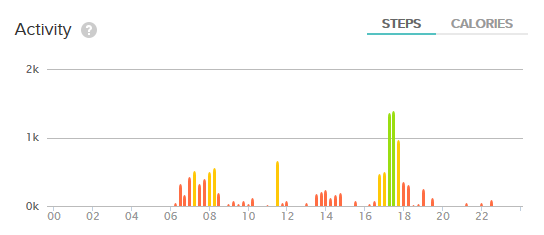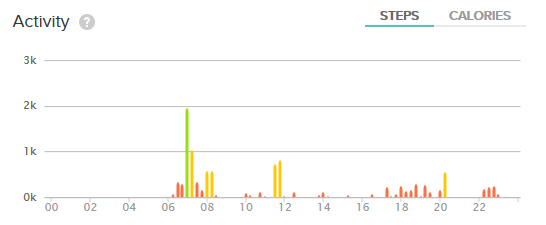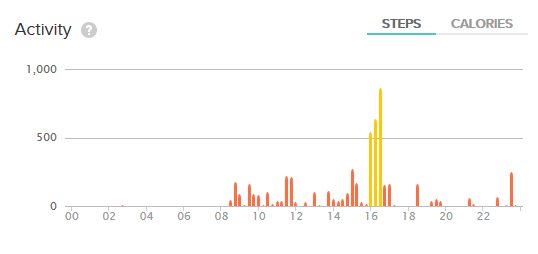The First Step to Getting Fit: Many Steps!
October 4, 2013I’ve decided to give this blog an additional facet and also write about my other big passion next to software development, which is - lo and behold - Fitness!
Of course, fitness and the process of getting into shape involve many different aspects and I hope to cover a lot of them in future blog posts. But, with this magnitude of aspects, we often tend to overlook the simplest and most basic aspect when it comes to physical fitness: Walking!
Since you have landed on my blog, where a lot of posts cover topics around software and software development, I can safely assume that your daily routine is pretty much the same as (or at least similar to) mine:
- Getting to the office in the morning.
- Sitting and working there for nearly the whole day.
- Going back home in the evening.
The typical daily routine of a software developer simply does not include much walking.
Or as fellow Boromir would put it:

But we’re going to change that, because walking and trying to reach a minimum amount of daily steps is fundamental for a fit and healthy life style. An occasional run or working out once or twice a week and hardly moving at all during the rest of the days is simply not enough and will not get you towards your fitness goals.
Therefore your goal should be to also get a decent amount of steps and body movement on your “not so active days” (i.e. days without running, working out or doing other sports). And here’s how to achieve that goal.
Measure!
Basically, for fitness the same rules apply as for software development. If you want to increase performance you have to:
- measure first
- then tweak, adapt and optimize
- after that measure again.
The important thing here's to actually get some real data to work with, i.e. you have to count your daily steps.
So get yourself a pedometer to count and keep track of your daily steps.
You can get pedometers in all different colors, sizes, shapes and price ranges. With price of course, the quality varies, but don’t get too hung up on accurate measurements of every single step you take. We are mainly interested in consistency of the results and trends over time. Therefore I suggest a pedometer which allows for easy or automated export of its data for later analysis. I personally use a FitBit Flex and I love this device. My wife owns a FitBit Zip, which is similarly awesome. I fact, I think I will do a future blog posts entirely on our FitBits and how we use them.
Just to be clear, I am not affiliated with FitBit in any way. I just think they do an awesome job when it comes to building pedometer hardware and software and that’s why I absolutely recommend them.
Set a goal!
Now set a daily step goal - but make sure it’s realistic. My FitBit e.g. automatically set a 10.000 steps per day goal for me, which is a good goal on average. It’s a bit of a stretch on a typical work day but on “active” days I hit that target easily. So over the week it’s evening out and I found this to be a good goal for me.
Here are a few examples how this daily step analysis looks like on the FitBit dashboard:
12.117 Steps
Here I managed a bit over 10.000 steps. You can see some activity in the morning, when I was working out at the gym. Then some activity around midday where I took a short walk to get lunch and some good activity in the evening where I went for a walk with family.
10.929 Steps
Here’s another example where I hit my step goal. You can see some good activity in the morning. Again at the the gym, but this time I obviously spent some time on the treadmill for I had way more steps compared to the previous picture, where I probably was “just” weight lifting. Then we again see some activity where I went for a walk to get lunch and some minor activity in the evening.
5.459 Steps
The last diagram shows a day where I obviously missed my target and had an embarrassingly low step count. These is very much the kind of day we want to avoid, and next we look at a few options how to do that.
How to Boost your Step Count
I am really trying hard to hit my daily goal of 10.000 steps. It’s not always easy but here are a few tricks how it can be done regardless:
- Try to start your day with some exercise. Either walk to work or at least use public transport since this usually involves some walking too.
- If walking to work is not an option for you, go for a morning run or hit a gym (they usually open really early) before going to work.
- At the gym if you are lifting weights or working on machines, walk around between your set breaks. Your muscles can still recover but you get “extra” steps. Works great for me!
- If you’re working from home, get yourself a treadmill and work while walking on it for an hour per day. This really is possible. Here’s an example of someone doing that.
- At the office, it’s usually not that easy to set up a treadmill desk, but maybe you can try the technique of walking meetings.
- If that’s also not possible (like in my case) try to get as many steps as possible during your breaks. Choose the most distant restaurant or shop possible to get your lunch and walk to it. It’s raining? So what, walk!
- Back at home, go out for a walk.
- Or get on the treadmill while watching Breaking Bad or playing Xbox. Remember: you don’t have to actually run here, an easy walking pace is all we aim for here.
TL;DR: Get a pedometer. The simple fact that your step count is now monitored will make you walk more. Worked for me.



